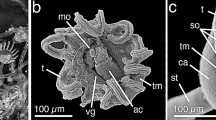Abstract
The tentacular apparatus of Coeloplana bannworthi consists of a pair of tentacles which bear, on their ventral side, numerous tentilla. Each tentacle extends from and retracts into a tentacular sheath. Tentacles and tentilla are made up of an axial core covered by an epidermis. The epidermis includes six cell types: covering cells, two types of gland cells (mucous cells and granular gland cells), two types of sensory cells (ciliated cells and hoplocytes), and collocytes, this last cell type being exclusively found in the tentilla. The core is made up of a fibrillar matrix, the mesoglea, which is crossed by nerve processes and two kinds of smooth muscle cells. Regular muscle cells are present in both the tentacles and tentilla while giant muscle cells occur exclusively in the tentilla. The retraction of the tentacular apparatus is an active phenomenon due to the contraction of both types of muscle cells. The extension is a passive phenomenon that occurs when the muscle cells relax. Tentacles and tentilla first extend slightly due to the rebound elasticity of the mesogleal fibers and then drag forces exerted by the water column enable the tentacular apparatus to lengthen totally. Once the tentacles and tentilla are extended, gland cells, sensory cells, and collocytes are exposed to the water column. Any swimming planktonic organism may stimulate the sensory cilia which initiates tentillum movements. Pegs of hoplocytes can then more easily contact the prey which results in a slight elevation of the nearby collocytes, the last being responsible for gluing the prey to the tentilla.
Similar content being viewed by others
Author information
Authors and Affiliations
Additional information
Accepted: 1 April 1997
Rights and permissions
About this article
Cite this article
Eeckhaut, I., Flammang, P., Lo Bue, C. et al. Functional morphology of the tentacles and tentilla of Coeloplana bannworthi (Ctenophora, Platyctenida), an ectosymbiont of Diadema setosum (Echinodermata, Echinoida). Zoomorphology 117, 165–174 (1997). https://doi.org/10.1007/s004350050041
Issue Date:
DOI: https://doi.org/10.1007/s004350050041




